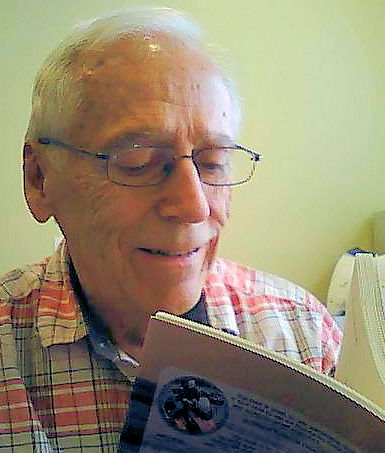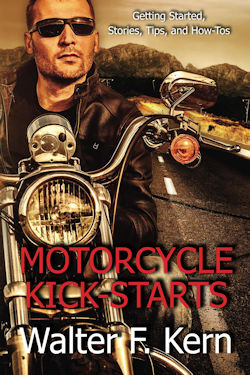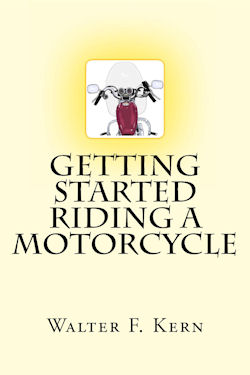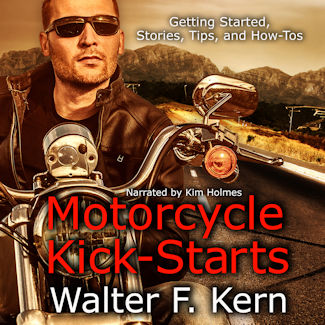2000 Gold Wing SE Motor Trike Test By Walter F. Kern Testing the Motorcycle Trike and its Features After that early ride, I took the motorcycle trike out twice to ride to Polar Bear Grand Tour meetings. I put a total of about 150 miles on the trike riding at speeds up to 65 mph. The motorcycle trike is equipped with gas shocks and a so-called airbag suspension system that is hooked up to the standard Gold Wing air compressor system. The trike uses BF Goodrich Radial T/A tires, 235R 60 X 15. It comes with a three-year or 36,000 mile warranty. I ordered mine with a trailer hitch, Roadhawk wheels with spinner upgrade, Ring-of-Fire lights on the front wheel, front fork lights, master cylinder light switch to control all new lights, wind deflectors, ISO highway boards, ISO pegs, tombstone taillights with gold eagle red lens on top, license light bar, lower rear bumper with Kuryakyn lights and shields, lighted mud flaps, trunk rack, trike cover, trunk liner, and trunk rack bag. Oh, and I tossed in a change holder too. The best things about the trike are that you no longer need to be concerned about grated bridges, snow packed roads, parking lots and gas stations with ice and snow, continual stopping and starting in heavy traffic, gravel and stone parking lots and driveways, losing your balance if you have to make a quick stop and tipping your trike over while stopped. The new things to worry about are learning that you are not on a bike any more and remembering that the trike is wide and you have to compensate when you pull in next to a gasoline island or a toll plaza. You also get poorer gas mileage -- 30 instead of 38 mpg. There are also more mechanical concerns since you now have half motorcycle and half car. There are more problems being delayed while traveling since almost no one has ever seen a trike before and they all come running to ask questions -- some even yell questions to you out of their car windows and some cars have been known to drift into your lane as they try to "look you over." Also, you have to remember to leave the trike in gear when you park it or risk having it roll away. Some trikers purchase a hand brake for this purpose. While cruising at a steady 65 mph, the trike is highly stable. Cross-winds don't normally affect you but a passing truck will be noticed. Easy highway turns are simple to negotiate. A light touch on the handlebar grips with easy motions will take you anywhere. Tight turns or decreasing radius turns on entrance and exit ramps are noticeably more difficult and require steady pressure. Lines through curves are recommended but this is a technique best learned by practice. I'm told by the CEO of Motor Trike, that a good trike rider can beat a good motorcycle rider through Deal's Gap knowing the proper technique. I have more practice ahead of me on that one.
Most trikes prior to 2001 were built on the Honda Gold Wing 1500 platform since it was readily available, very stable, had sufficient power and a low center of gravity. There was also a new option of a fuel cell that added an additional 3 1/2 gallons of fuel. The Classic II trunk on my trike is supposed to have the same capacity as the two saddlebags normally fitted to the Gold Wing. As mentioned before, the biggest difficulty with becoming familiar with a trike is getting used to the steering. I'm not kidding when I say that most of the trike accidents occur right after the owner takes possession and drives off thinking he or she is on a motorcycle. It's a really weird sensation the first time you try to pull over to the right by pushing the right handlebar grip and find yourself headed straight for an 18-wheeler in the oncoming lane. You've been warned! You must steer a trike like a car. There is no steering wheel so you have to imagine that the handlebars are just part of a huge steering wheel that's been cut off at the bottom. If I see I have to make a right hand turn ahead, I think of pushing the left handlebar grip forward toward the direction of the turn. If I see a left hand turn coming, I think of pushing the right handlebar grip forward toward the direction of the turn. I'm told this will become second nature with practice. I do know that I can easily get off the trike and hop on my Sporty and ride it with no problems. I guess the imprinted motorcycle program is ingrained. I haven't ridden my trike long enough yet to create the trike imprint. I guess a good long trip should do it. (Note: I finally figured out that the easiest way to steer a trike is to pull the handlebar grip back. For example, to turn right, pull the right handlebar grip back. You can also help the turn by also pushing the left handlebar grip forward but the main emphasis should be on pulling.) I've included some pictures of the trike showing some of the details I've described here. Click below for thumbnail pictures that will lead you to larger pictures with descriptions. If you ride a trike, are thinking about it, or know someone else who is a triker, stay in touch. Triking is here to stay. You too may find a trike in your future. => Back to Page 1: Becoming a Triker |
||||
© 2017 Walter F. Kern. All rights reserved.
|













